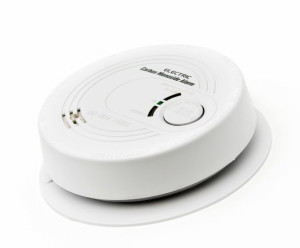To commemorate the month of October being Fire Prevention Month, Unlimited Security is continuing to share with you some information concerning safety practices to prevent injuries or death due to problems with combustion of fuel for heating and cooking. In this post, we want to focus on carbon monoxide and how to protect yourself and your family from the possibility of being poisoned by this toxic gas.
What is carbon monoxide?
Carbon monoxide is a deadly poisonous gas that can be very dangerous as carbon monoxide is odorless and tasteless, which makes it impossible to detect without a carbon monoxide alarm.
What are some common sources of carbon monoxide in the home?
 Generally, carbon monoxide is produced in the home when a chimney blockage, deteriorated chimney liner, or damaged furnace heat exchanger allows this toxic gas to leak into the house. Backdrafting chimneys and flues can also cause carbon monoxide to enter the home. Additionally, gas stoves and ranges can also produce carbon monoxide, which can cause issues if the appliances are used for a prolonged period of time or if they are not operated properly. You should never try to heat your home with a gas stove.
Generally, carbon monoxide is produced in the home when a chimney blockage, deteriorated chimney liner, or damaged furnace heat exchanger allows this toxic gas to leak into the house. Backdrafting chimneys and flues can also cause carbon monoxide to enter the home. Additionally, gas stoves and ranges can also produce carbon monoxide, which can cause issues if the appliances are used for a prolonged period of time or if they are not operated properly. You should never try to heat your home with a gas stove.
How many people are unknowingly affected by carbon monoxide leaks in the home?
According to the US Consumer Product Safety Commission (CPSC), about 170 people on average die every year in the United States from carbon monoxide produced by non-automotive consumer products. Furthermore, approximately several thousand people are treated in hospital emergency rooms every year for both low-level and high-level carbon monoxide poisoning.
What are the symptoms of carbon monoxide poisoning?
Carbon monoxide negatively affects the ability of hemoglobin to transport oxygen throughout the body because the toxic gas bonds to hemoglobin in red blood cells. Symptoms of low-level carbon monoxide poisoning include weakness, fatigue, dizziness, nausea, aching muscles, headache, vomiting, and sleepiness. As these symptoms are very similar to those of the flu, it can be difficult to diagnose exposure to carbon monoxide. If you do not notice your symptoms disappearing within a couple of weeks or if your entire family, including your pets, have these same symptoms, you should ask your doctor to test your blood for the presence of carbon monoxide. Continued exposure to this toxic gas leads to high-level carbon monoxide poisoning, which causes impaired thinking and judgment, confusion, paralysis, coma, and, eventually, death.
How can I best protect myself and my family from carbon monoxide poisoning?
Firstly, have your chimney cleaned and inspected annually by a Chimney Safety Institute of America (CSIA)-certified chimney sweep. Secondly, install carbon monoxide alarms on every level of your home and in every bedroom in your house.
What do I do if the carbon monoxide alarm sounds?
As soon as you hear the alarm, gather your family and pets and immediately go outside to call 911. Be sure everyone has gotten out of the house. Do not go back into your home until you are given permission from the emergency responders. If the source of the carbon monoxide is determined to be a broken appliance, do not use that appliance until it has been serviced by a certified technician.
Have any more questions about carbon monoxide? Contact us to ask our expert staff for more safety tips and alarm recommendations.
